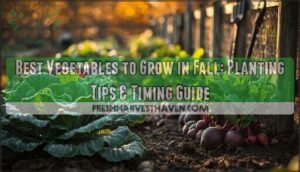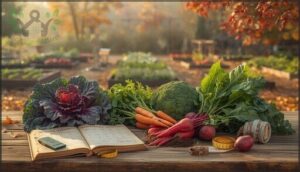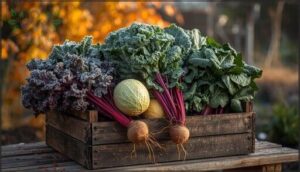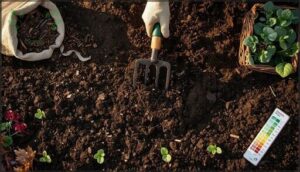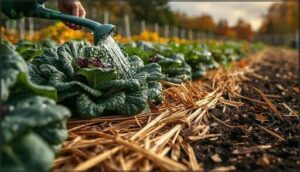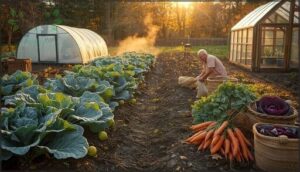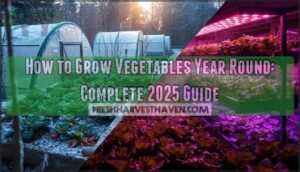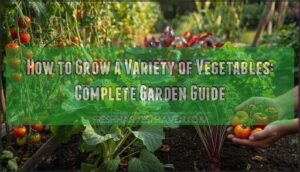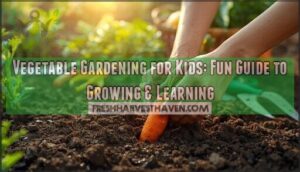This site is supported by our readers. We may earn a commission, at no cost to you, if you purchase through links.
Summer’s heat fades, and most gardeners assume their growing season ends with the tomatoes. That’s the moment you can seize control of your garden’s productivity. Cool-weather crops don’t just survive autumn—they thrive in it, delivering sweeter flavors and denser nutrition than their summer counterparts.
Spinach leaves thicken after the first frost. Carrots convert starches to sugars when temperatures drop. Kale becomes almost impossibly tender under a light freeze. You’re not extending the season by planting the best vegetables to grow in fall; you’re entering the time when many crops reach their peak potential.
The narrow window between late summer and frost allows for multiple harvests if you understand timing, variety selection, and the soil preparation that sets cold-hardy crops up for success.
Table Of Contents
- Key Takeaways
- Top Vegetables to Grow in Fall
- When to Plant Fall Vegetables
- Choosing The Best Fall Varieties
- Preparing Soil and Planting Techniques
- Extending and Harvesting The Fall Garden
- Frequently Asked Questions (FAQs)
- What is the best vegetable to plant in the fall?
- When should I start my fall garden?
- What vegetables are good in the fall?
- What is the best vegetable to grow in autumn?
- What is the best vegetable to plant in autumn?
- Is September too late to plant fall vegetables?
- What plants are best to plant in the fall?
- What is the best vegetable to grow in the fall?
- What vegetables are best to plant in the fall?
- What are the best vegetables to plant in fall?
- Conclusion
Key Takeaways
- Fall-planted cool-season crops like spinach, kale, and carrots actually taste sweeter and become more tender after frost exposure because dropping temperatures trigger the conversion of starches into natural sugars.
- Successful fall gardening depends on working backward from your first expected frost date and matching each crop’s maturity time—leafy greens need 6-8 weeks, root vegetables require 10-12 weeks, and quick radishes mature in just 3-4 weeks.
- Proper soil preparation with compost addition, cover cropping between seasons, and mulching makes the difference between mediocre and abundant fall harvests by improving water retention and protecting roots from temperature swings.
- You can extend your harvest well past the first frost by using row covers and cold frames that boost temperatures by 2-10°C, while proper storage techniques like root cellaring at 32-40°F can preserve crops for 3-5 months.
Top Vegetables to Grow in Fall
Fall gardening gives you a second chance to fill your plate with fresh, homegrown produce—and in many ways, it’s easier than spring. Cool-season crops actually prefer the dropping temperatures and shorter days, often tasting sweeter after a light frost.
Fall gardening offers a second chance at fresh produce, with cool-season crops thriving in dropping temperatures and tasting sweeter after frost
Here are the best vegetables to plant now for a productive autumn harvest.
Leafy Greens for Cool Weather
Leafy greens thrive when cool season temperatures arrive, transforming your fall garden into a nutrient-dense powerhouse. You’ll find these crops sweeter and more tender than their summer counterparts:
- Spinach – Plant six to eight weeks before frost; cold boosts spinach growth and leaf thickness while sweetening flavor
- Kale – Frost-tolerant and packed with kale nutrition that intensifies after light freezes
- Arugula – Ready in 20–50 days with peppery arugula flavor enhanced by cool weather
Lettuce harvest continues through autumn with succession sowings, while Swiss chard benefits from mild freezes. Collard greens hold strong into late fall, giving you reliable harvests when other crops fade.
Researchers have found that cold weather conditions play a significant role in producing tastier spinach.
Root Vegetables Ideal for Autumn
Beyond greens, root vegetables anchor your autumn harvest with unrivaled storage potential. Carrots and beets thrive in cooler soil—55 to 75°F—germinating reliably where summer heat failed. Parsnips sweeten after frost exposure, while turnips race to maturity in just 30 to 60 days.
With proper root cellars, you’ll keep carrots and beets for six months, turning fall planting into winter abundance through smart crop rotation and soil preparation. For ideal growth, understanding root crop care is essential for a successful harvest.
Brassica Family Favorites
The brassica family—broccoli, cauliflower, kale, cabbage, and Brussels sprouts—thrives in fall’s chill, tolerating frosts down to -15°C once acclimated. These cool season crops excel at brassica nutrition while offering months of vegetable storage.
Transplant seedlings 8 to 10 weeks before your first frost, spacing plants 30 to 45 cm apart. Smart crop rotation minimizes pests, and their frost tolerance means you’ll harvest into early winter.
Fast-Maturing Fall Crops
When garden planning calls for speed, radishes deliver in just 21 to 30 days—perfect for crop rotation between slower fall vegetables. Lettuce and spinach aren’t far behind at 35 to 50 days, thriving when soil temperature drops in late summer.
These cool season crops let you squeeze multiple succession plantings into autumn’s narrow window, keeping your fall harvesting continuous right up to frost.
When to Plant Fall Vegetables
Timing is critical for fall planting—get it right, and you’ll harvest fresh vegetables well into the colder months. The key is working backward from your first expected frost date and matching it to each crop’s maturity time.
Let’s break down how to calculate your planting windows, time different vegetable types, and use succession planting to keep your harvest going strong.
Calculating First Frost Dates
Knowing your first frost date is the foundation of fall gardening success. You can find this critical timing using the USDA Plant Hardiness Zone Map, local extension offices, or tools like the Farmer’s Almanac calculator.
For instance, Chicago averages its first freeze around October 28, while Seattle doesn’t see frost until December 1. These frost-tolerant vegetables thrive when you plan backward from that date.
Timing for Different Vegetable Types
Timing your fall planting depends on each vegetable’s maturation speed and frost tolerance. Leafy greens like spinach need 8 weeks before frost, while quick radishes mature in just 3-4 weeks. Root vegetables such as carrots require 10-12 weeks, and brassicas like broccoli need transplanting 10 weeks ahead.
Calculate backward from your frost date, adding days to maturity for accurate seasonal schedules and successful harvest timing.
Succession Planting Strategies
Succession sowing keeps your fall vegetable garden producing non-stop until frost. Plant lettuce and spinach every 7 to 14 days for continuous harvests, while slower crops like broccoli and beets work on 14-day intervals. This harvest management approach prevents feast-or-famine cycles.
Pair fast radishes with slow-growing cabbage in the same bed—spatial planning that maximizes every square foot through smart crop rotation and seasonal gardening timing.
Choosing The Best Fall Varieties
Not every vegetable variety will thrive when planted late in the season. Some varieties handle frost better than others, while certain cultivars are specifically bred to mature quickly in cooler temperatures and shorter daylight.
Choosing the right varieties for your fall garden means looking beyond what worked in spring and selecting plants designed to succeed as the season winds down.
Frost-Tolerant Vegetable Options
Not all cool season vegetables can weather a hard freeze—but some are built for it. Cold hardy crops like spinach, kale, and Swiss chard tolerate temperatures down to 20°F, while winter vegetable options including collards, broccoli, and parsnips handle even colder snaps.
You’ll want freeze resistant vegetables for reliable winter harvest: choose frost tolerant plants that thrive in cool season gardening and keep producing when others fade.
Best Varieties for Shorter Days
When daylight shrinks below twelve hours, your fall crop selection hinges on daylength insensitivity. Short day varieties like ‘Purplette’ onions (60 days) and ‘Roma II’ beans adapt to cooler, dimmer conditions without stalling.
Leafy cool season crops—spinach ‘Matador’ (28 days), kale ‘Red Russian’ (50 days)—thrive under shortened photoperiods, while frost tolerant vegetables bred for photoperiod management keep producing as autumn fades.
Selecting Seeds for Overwintering
Overwintering techniques transform your fall vegetables into spring-season seed producers—if you choose biennial crops bred for cold hardiness. Vernalization methods, where you expose seeds to 1–3 weeks at 5°C before sowing, shorten growth cycles and boost germination in cool weather crops like beets and brassicas.
- Tier 1 winter gardening survivors: Russian kale, spinach, and tatsoi endure -2.2°F with row cover protection
- Seed selection priorities: Look for “overwintering” or “hardy” labels on cold weather crops catalogs
- Frost tolerant vegetables: ‘Vates’ kale and ‘Oslo’ leuks survive near -5°F, delivering continuous harvests
- Root-to-seed strategy: Harvest biennials, cold-store roots, then replant for seed production in mild climates
Preparing Soil and Planting Techniques
Your fall garden succeeds or fails based on what happens before a single seed hits the ground. Summer-worn soil needs some TLC to give cool-season crops the start they deserve, and planting techniques shift slightly as temperatures drop.
Let’s walk through how to prep your beds, nail your planting depth, and keep moisture levels right where your vegetables need them.
Improving Soil for Fall Crops
Before you plant, arm yourself with knowledge: soil testing reveals exactly what your garden needs. Test every 2 to 3 years to track pH and nutrients. Most vegetables thrive in slightly acidic conditions, and labs calculate precise lime requirements to dial in that sweet spot.
| Amendment | Guideline |
|---|---|
| Compost Addition | Max 3 inches tilled into top 6 inches (50% by volume) |
| Annual Maintenance | Limit to 1 inch compost per year to avoid imbalances |
| Organic Matter Target | Maintain at least 2% for general gardens, higher for intensive beds |
| Cover Crops | Plant winter rye, oats, crimson clover, or hairy vetch between crops |
| Mulching Benefits | Reduces evaporation, suppresses weeds, insulates roots from temperature swings |
Organic matter is your secret weapon in fall gardening. Incorporating compost, pine bark fines, or shredded leaves improves water retention and aeration in any soil type. In warm climates, decomposition races along, so yearly additions keep fertility strong. Turn soil 7 to 8 inches deep when mixing amendments, and if you’re adding raw leaves in fall, toss in supplemental nitrogen to fuel microbial breakdown.
Cover cropping transforms tired beds. Oats winterkill around 10 to 20 degrees Fahrenheit, leaving residue that rebuilds structure. Legumes like crimson clover fix nitrogen biologically, cutting your fertilizer bill. Thickly sown grasses tackle compaction and erosion while shading bare ground between vegetable plantings.
Mulching pays dividends across the board. A protective layer keeps soil cooler in lingering heat and warmer when frost arrives, reducing stress on fall crops. It absorbs rainfall better than bare ground, limits crusting, and slashes weed pressure without disturbing your carefully prepared beds—a conservation win that protects tilled soil from wind and rain.
Correct Seed Depth and Spacing
Getting your seeds into the ground at the right depth and spacing makes all the difference in germination rates and final yields. Most seeds follow a simple rule: plant them about twice their diameter deep, adjusting for soil type. Small seeds like lettuce go shallow at 1/8 inch, while larger ones like turnips settle at 3/4 inch.
- Leafy greens require minimal depth—spinach and kale at 1/4 inch, arugula at the same
- Root vegetables need slightly deeper placement—carrots at 1/4 to 1/2 inch, beets at 1/2 inch
- Brassicas do well at moderate depths—broccoli and cabbage at 1/4 to 1/2 inch deep
- Spacing varies widely—radishes need 20 seeds per foot while Brussels sprouts want 18 to 24 inches
- Dense planting works for baby greens—60 lettuce seeds per foot in narrow bands
Mulching and Irrigation Tips
Once your seeds are in place, mulch and water work together to keep fall vegetables thriving. Apply a 2-inch layer of straw or shredded leaves to regulate soil moisture and cut evaporation by up to 33%.
Most fall crops need 1 to 2 inches of water weekly—adjust irrigation scheduling based on rainfall and soil needs for smart water conservation.
Extending and Harvesting The Fall Garden
Your fall garden doesn’t have to end with the first frost. With a few simple techniques, you can protect crops, harvest at just the right moment, and store your bounty for months.
Let’s walk through the essentials of stretching the season and making the most of every vegetable you’ve grown.
Using Row Covers and Cold Frames
Row covers and cold frames act like thermal blankets for your fall vegetables, boosting temperatures by 2–10°C and shielding crops from frost when cold weather strikes.
These season extension tools provide essential frost protection and microclimate management, allowing cool weather gardening to continue weeks beyond normal.
You’ll see faster growth, higher yields, and extended winter harvesting—without the cost of a greenhouse.
Timing Harvests for Peak Flavor
Knowing exactly when to harvest fall vegetables dramatically improves flavor and texture. Cold weather triggers sugar accumulation in frost-tolerant crops, transforming bitterness into sweetness—but timing is everything.
- Wait for frost on brassicas and root crops. Brussels sprouts, kale, carrots, and parsnips develop peak sugar content and mellow flavor after exposure to at least one light frost, as cold stress converts stored starch into natural antifreeze sugars.
- Harvest leafy greens at ideal maturity. Pick spinach when it has four to five true leaves and lettuce when heads are fully formed but before leaves elongate—size matters more than calendar dates for tender texture and mild flavor.
- Cool produce immediately after harvest. Cut vegetables during cool morning hours and refrigerate promptly to 35–40°F; delaying cooling by just four hours can slash storage life nearly in half and compromise flavor quality.
Storing and Preserving Fall Vegetables
Proper storage transforms your fall harvest into months of fresh eating. Root cellars and cold storage areas work wonders when you match crops to their ideal conditions—some vegetables crave cold, while others need warmth.
| Storage Method | Best Vegetables | Conditions & Duration |
|---|---|---|
| Root cellar (32–40°F, high humidity) | Carrots, beets, turnips, parsnips | 90–95% humidity; 3–5 months |
| Cool, dry storage (55–59°F) | Winter squash, pumpkins, onions, garlic | Cure first; 2–6 months |
| Refrigerator (35–40°F, high humidity) | Leafy greens, broccoli, cabbage, Brussels sprouts | High-humidity drawer; 1–3 weeks |
| Canning (pressure or water bath) | Green beans, tomatoes, pickled vegetables | Pantry stable; 1–2 years sealed |
| Freezing (0°F or below) | Blanched greens, peppers, herbs, cooked squash | Vacuum-sealed preferred; 8–12 months |
- Separate chilling-sensitive crops from cold-lovers. Winter squash and pumpkins suffer damage below 50°F, so store them separately from root vegetables that thrive near freezing—mixing them cuts storage life dramatically.
- Cure before long-term storage. Let winter squash sit in warm conditions (70–80°F) for 10–14 days to harden skins and heal surface wounds; properly cured squash can last six months while uncured fruit rots within weeks.
- Can low-acid vegetables safely. Pressure canners reach 240–250°F to destroy harmful bacteria in green beans, carrots, and other low-acid fall vegetables—water bath canning isn’t hot enough and creates serious safety risks.
Frequently Asked Questions (FAQs)
What is the best vegetable to plant in the fall?
Leafy greens like spinach and kale thrive as cool season crops, tolerating hard frosts down to 25–28°F.
They’re perfect for fall vegetable gardening since both mature quickly and improve in sweetness after light freezes.
When should I start my fall garden?
Start your fall garden 8 to 10 weeks before your first frost date for most cool weather crops.
Counting backward from that frost date ensures autumn harvest prep timing matches days to maturity and seasonal planting needs.
What vegetables are good in the fall?
You can grow kale, spinach, carrots, beets, broccoli, and radishes in your fall garden.
These cool season crops thrive in autumn’s cooler temperatures, with many frost tolerant plants offering sweeter flavors after light frosts.
What is the best vegetable to grow in autumn?
There’s no single “best” vegetable—your autumn crop selection depends on garden planning tips and regional climate.
Cool weather crops like kale offer outstanding vegetable hardiness and seasonal nutrition, thriving in fall conditions many other plants can’t handle.
What is the best vegetable to plant in autumn?
Radishes stand out for autumn planting because they mature in just 30 days, letting you squeeze in multiple harvests before frost.
Their quick turnaround makes them perfect for cool-season gardening in shorter growing windows.
Is September too late to plant fall vegetables?
It depends on your climate and frost dates. In zones 7–8, quick-maturing cool-season crops like radishes, lettuce, and spinach can still yield a fall harvest when planted in early September.
What plants are best to plant in the fall?
Your autumn garden thrives with cool season crops like leafy greens, root vegetables, and brassicas.
Plan vegetable planting around frost tolerance strategies—lettuce, spinach, carrots, and kale handle cold beautifully, giving you fresh seasonal harvests.
What is the best vegetable to grow in the fall?
Like clockwork, the season shifts and delivers a second chance at green abundance.
Spinach stands out as your best fall vegetable—maturing in just 40 days, thriving in cool weather, and sweetening after frost touches its leaves.
What vegetables are best to plant in the fall?
Your fall garden thrives with cool-season crops like spinach, kale, and lettuce—all germinating in chilly soil.
Additionally, fast-maturing radishes, carrots, and hardy brassicas such as broccoli and cabbage sweeten after frost.
What are the best vegetables to plant in fall?
Smart seasonal planting starts with cool-season crops like spinach, kale, and carrots—cold-weather champions that thrive when temperatures drop.
Radishes race to maturity in weeks, while brassicas develop sweeter flavors after frost touches your fall garden.
Conclusion
Most gardeners won’t discover what their soil can truly produce until they challenge the assumption that cold ends growth. The best vegetables to grow in fall don’t merely tolerate autumn—they demand it, transforming stress into sweetness and frost into flavor.
Your timing, variety choices, and soil preparation determine whether you’re simply extending a season or unlocking harvests that summer never offered. The question isn’t whether to plant, but what you’re willing to miss.
- https://www.purdue.edu/hla/sites/yardandgarden/leafy-vegetables-ready-for-short-cool-growing-season/
- https://www.motherearthnews.com/organic-gardening/fall-garden-vegetables-zmaz09aszraw/
- https://homelyhens.com/vegetable-gardening/what-to-plant-in-a-fall-garden/
- https://sowrightseeds.com/blogs/planters-library/what-to-plant-in-a-fall-vegetable-garden
- https://www.acadlore.com/article/OF/2022_8_1/of2022.08010003

